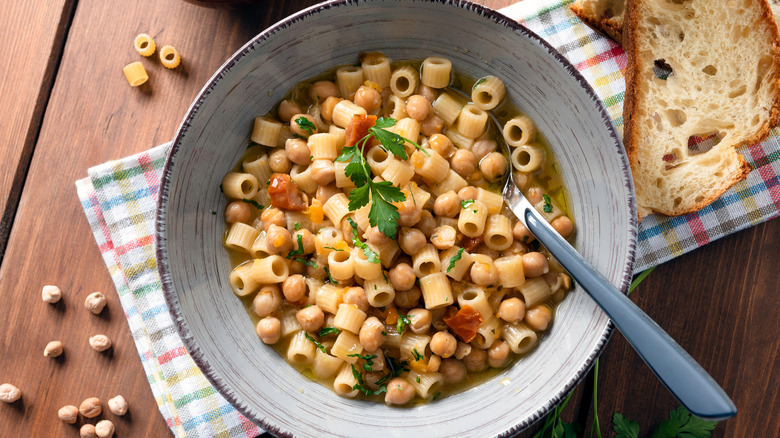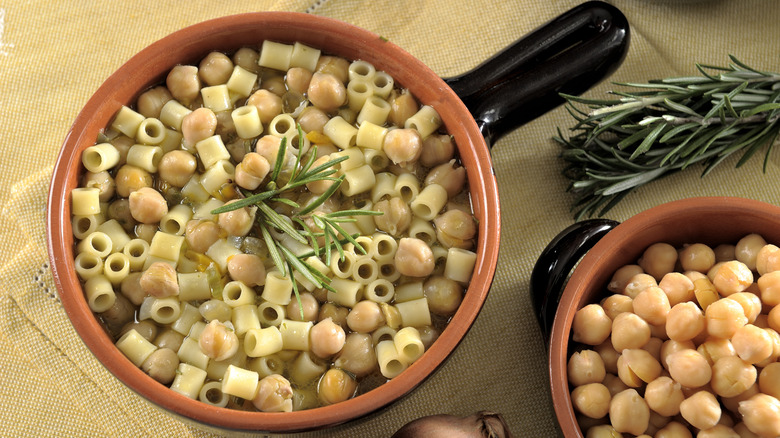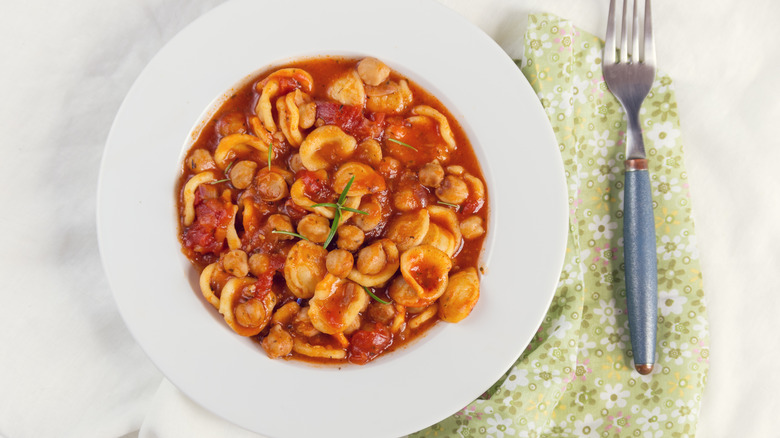Pasta E Ceci: The Underrated Italian Pasta Dish That Features Chickpeas
From a culinary perspective, to say that Rome is iconic is an understatement. It's the birthplace of pizza al taglio (aka, by the slice) and pecorino romano cheese. It's known for its earthy and exciting cuisine, and famous for foods from artichokes to tripe to gelato. But the beloved food that the capital of Italy may have mastered the most? Pasta, naturally.
The classic pasta dishes from Rome are carbonara, cacio e pepe, gricia, and amatriciana. And each is a unique Italian favorite in its own right — but there's so much more where those came from. So many other delicious pasta dishes that aren't as popular, fly under the radar or don't quite get enough credit.
One of those dishes is pasta e ceci, which literally means pasta and chickpeas. While you'll find this supremely comforting winter dish all over the country, each region with its own version, it's thought to have originated in Rome like so many other iconic recipes. If you're unfamiliar with pasta e ceci, it's time to change that.
How the Romans do pasta e ceci
Traditionally, there are two general rules to pasta e ceci. The first is that it's typically made with some sort of small or short pasta; think ditalini pasta or a small shell shape. The second is (you guessed it) that it includes chickpeas, which can be dried or canned. Other than that, the dish can take on many variations.
So what's the Roman version of pasta e ceci? First of all, it's made in the form of a thick soup or stew, similar to the Neapolitan pasta e fagioli. A small amount of diced tomatoes or puree is used, so it's not a heavy or rich tomato-based dish. It typically includes an herb like rosemary and is finished off with grated parmesan cheese. But there's one thing in particular that sets the Roman version of the dish apart: anchovies.
To add a deeper layer of flavor and a bit of a zing to the stew, traditional Roman recipes will typically start by sauteing some anchovies in oil with garlic, letting the salty fish melt into the pot. Then the tomatoes, chickpeas, herbs, and any other vegetables or proteins are added, before the pasta (along with some water or stock) is added to be cooked through in the warm, wintry, stewy goodness. The best part? This delicious dish only requires one pot.
The various versions of pasta e ceci
Pasta e ceci derives from the tradition of "cucina povera" (aka peasant cooking), which meant it was a dish created with simple ingredients that could be made with whatever happened to be on hand. So it makes sense that so many iterations of pasta e ceci exist because in a sense it's a dish that was made to be experimented with.
For some, it's a hearty soup or stew; for others, it's more of a classic pasta dish. Some use tomatoes and others leave them out. And an array of different kinds of vegetables and meats can be added to the mix, from leafy greens to potatoes to pancetta. All that to say — if anchovies aren't really your thing, there are plenty of other versions to try!
Different regions of Italy prepare the classic dish in different ways. In Naples, the dish is more of a dry pasta that's creamy rather than brothy or soupy. In Tuscany, they typically don't use any tomatoes, and you may even see chestnuts added to the dish in the fall. And in Puglia, pasta e ceci is served with mussels for a seafood twist on the classic. The good news is, no matter which direction you go, all roads lead to delicious.


